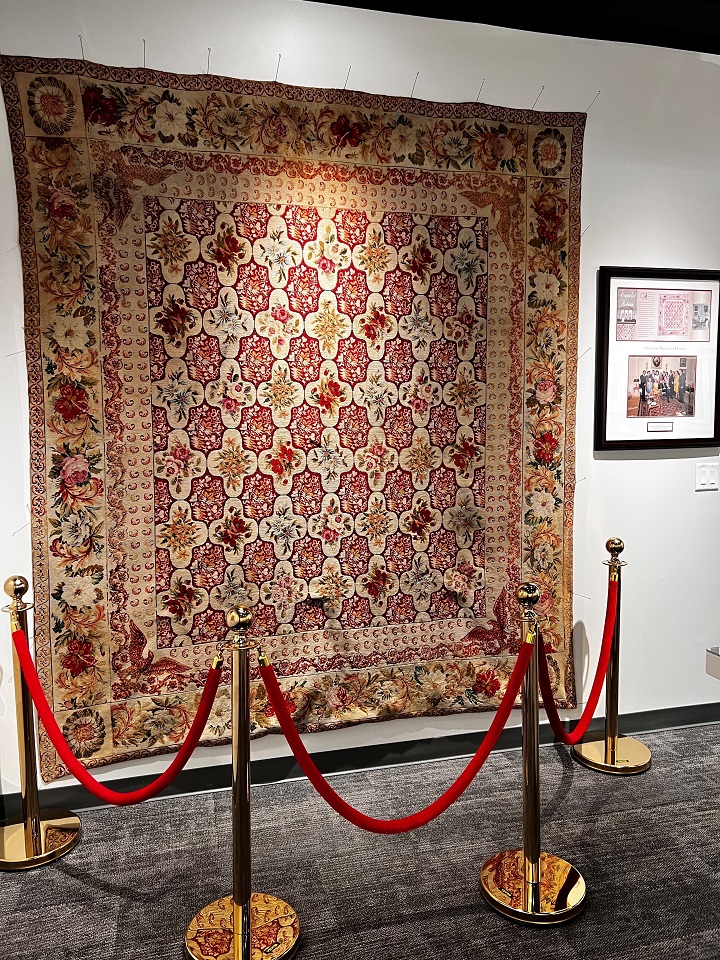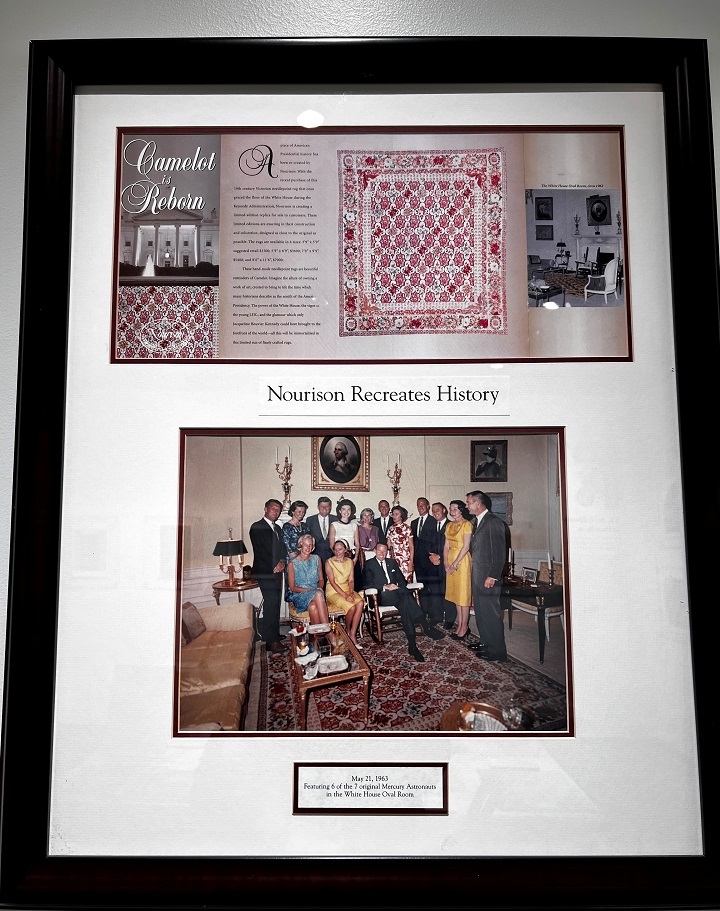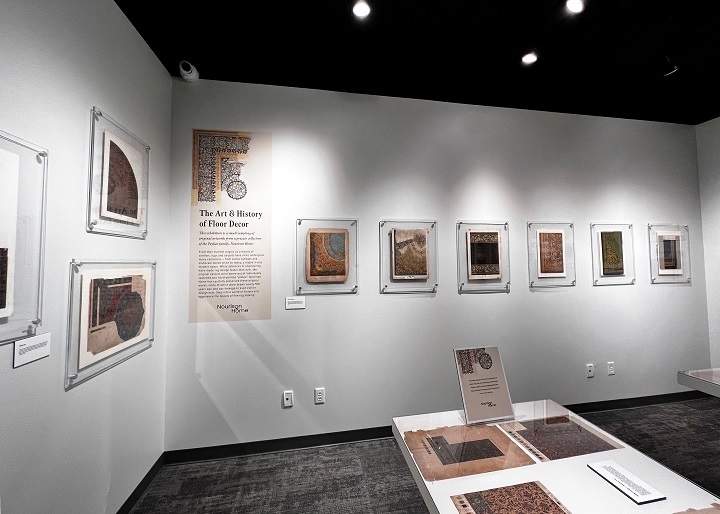Nourison's Peykar family provided sketched and hand-painted art plates from their archive reflecting key period
of rug-making history and design.
HIGH POINT, N.C., -- A collection of rare, hand-painted “art plates” once used to assist in the creation of intricate, hand-woven rug designs are on display in the Discovery Center gallery of the American Home Furnishings Hall of Fame during High Point Market, Oct. 14.-18
The Peykar family, founders of Nourison Home, have provided a sampling of original artworks featured in the exhibit. These individually sketched and hand-painted art plates reflect key periods of rug-making history and design. The plates, drawn nearly a century ago, have been carefully preserved by the Peykar family, and provide a rare glimpse into both the evolution of rug design as well as its deep connection to global culture and history.

A Nourison replica of the Victorian-style needlepoint Camelot area rug, which graced the Oval Room in the White
House during the Kennedy administration, is part of the Hall of Fame exhibit.

A White House photo from 1963 of President Kennedy and the First Lady alongside six Mercury astronauts, in the Oval
Room, which featured the Camelot rug, a Victorian needlepoint carpet.
“From their humble origins as a means of comfort, rugs and carpets have undergone many evolutions — from status symbols and elaborate works of art to today, a staple in modern spaces and lifestyles,” says Nourison Home Chairman Alex Peykar. “While advances in engineering have made rug design faster than ever, the ideas for the original carpets were borne out of individually sketched and hand-painted plates.”
According to Peykar, many of the plates in the Nourison Home collection were drawn nearly 100 years ago and pay homage to even earlier design eras. The plates reflect both the skill of the artists as well as the painstaking craftmanship that goes into making high-quality rugs.
“Rug making truly is an art,” he says. “The first step to crafting all rugs begins with tracing. Artists start by drawing on a sheet of tracing paper, fusing aspects of traditional design with the artist’s personal style. The tracing paper allows the artists to combine different motifs to create new, original artworks.”
After tracing, artists draft notes regarding color and scale to be used to create a full-sized plate of the rug. In handmade rug factories, one master singer calls out each color noted on the full-scale plate, each of which represents a knot woven into the final rug, Peykar says.
 The plates in the Nourison Home collection were drawn nearly 100 years ago and pay homage to even earlier design eras.
The plates in the Nourison Home collection were drawn nearly 100 years ago and pay homage to even earlier design eras.
In the special Discovery Center exhibit at the Hall of Fame, visitors will see rare examples of art plates incorporating these rug designs:
Aradabil: Inspired by the “Oldest Dated Carpet in the World,” the Ardabil Carpet was woven as part of a pair near the city of Kashan around 1539 to 1540 CE. While the original reason these rugs were crafted is contested, many believe them to have been a gift to Sheikh Safi al-Din in Aradabil. The hand-drawn replicas shown in the Hall of Fame exhibit feature intricate florals commonly associated with Islamic art, as well as a reimaging of the mosque pendant lamp that appeared in the original.
Aubusson: Named for the town in central France, where renowned weavers have been making tapestries since the 14th century. Aubusson-style rugs typically feature detailed florals and complex architectural design elements.
Directoire: A Neoclassical style paying homage to ancient Greece and Rome. The Directoire period of the decorative arts became popular toward the end of the French Revolution and favored classical motifs such as laurel wreaths and geometric shapes.
Empire: Introduced by Emperor Napoleon Bonaparte following the Directoire era, this period’s design elements included ribbons, sphinxes, amphoras and other prominent Greco-Roman motifs that came to be associated with Napoleon’s rule.
Kashan: Located in the Isfahan province of Iran, Kashan has long been known for producing some of the world’s finest rugs and carpets. Kashan design elements often include blossom and leaf patterns and medallions.
OCM-Symrna: Smyrna, now Izmir in Turkey, was an ancient Greek city on the coast of Anatolia. The now defunct Oriental Carpet Manufacturers, incorporated in London in 1908, was headquartered there and employed thousands of weavers in the region. Though the company’s factories later expanded to Iran and India, the Symrna-era designs fused aspects of traditional Persian and Turkish weaving with modifications favored by U.S. buyers. Some designs also were influenced by classic Chinese rugs.
Oushak: A small town south of Istanbul, Oushak has been a major center of rug production since the dawn of the Ottoman empire. These designs borrow heavily from Persian rugs and typically include medallions or other all-over floral patterns.
Ningxia: One of the oldest rug-weaving centers in China, Ningxia was a major rug producer during the 18th and 19th centuries. Rugs produced in this region often included traditional elements such as dragons and cloud bands, representative of the heavens.
Peking: Peking rugs, woven in Beijing, initially came into production after World War I for export to Europe and the U.S. Designs often incorporated Chinese art, Buddhist symbols and nature scenes. Patterns evolved over time to include aspects of Western design such as Aubusson style.
Tabriz: The city of Tabriz, capital of East Azerbaijan in Iran, is among the oldest and most famous weaving centers in the world. While designs produced are incredibly diverse, there are some staple elements that appear in traditional Tabriz carpets, including ornamental flowers with toothed leaves, cypress trees and arabesque stems.
“We are so privileged to be able to share this rare look inside vintage designs with the industry and the community at large,” said Karen McNeill, CEO and president of the Hall of Fame board of directors. “It’s just one example of the many treasures to be found in the industry’s new home and an example of an only-at-the-Hall of Fame experience.”